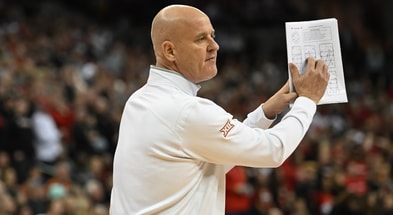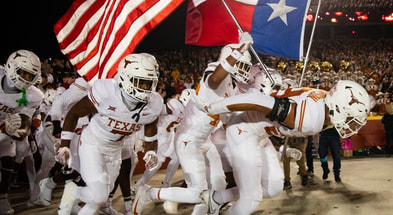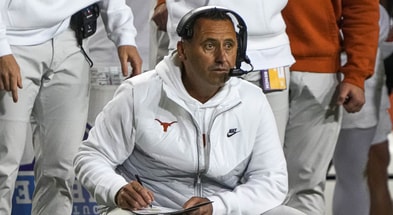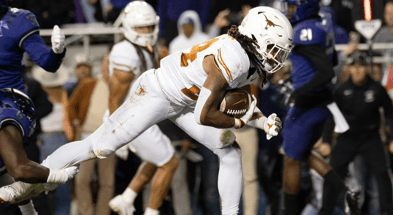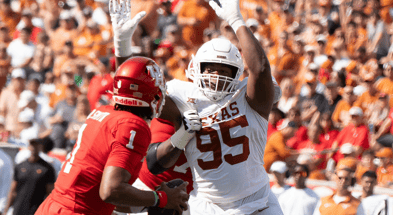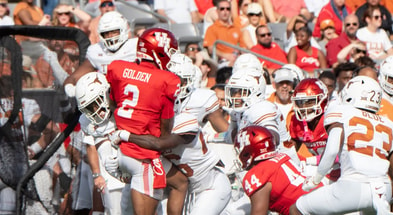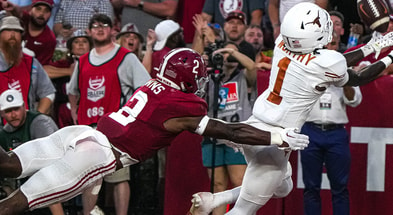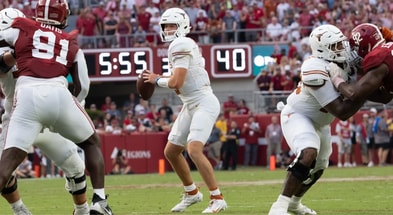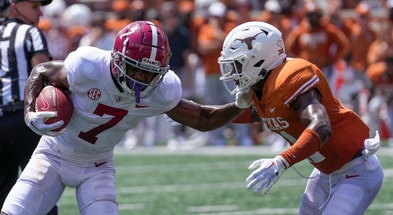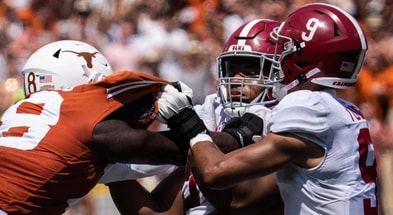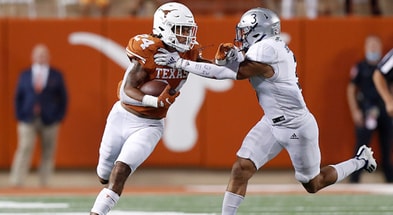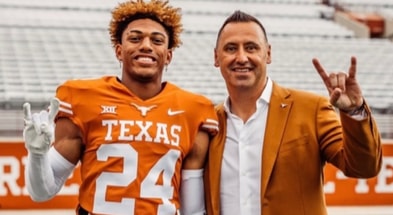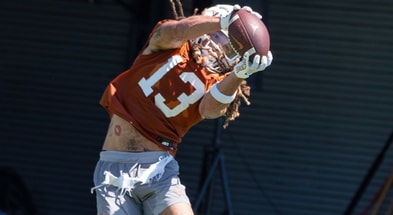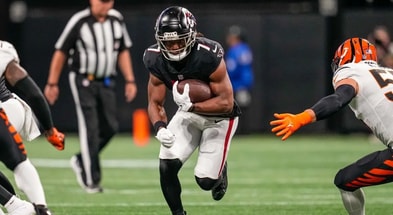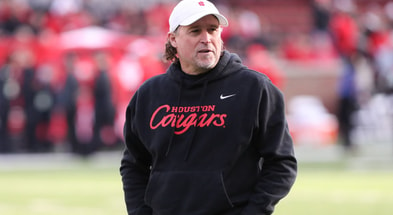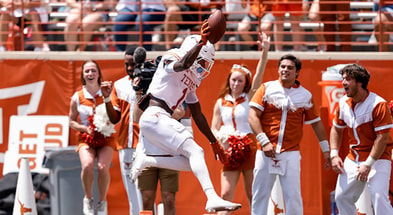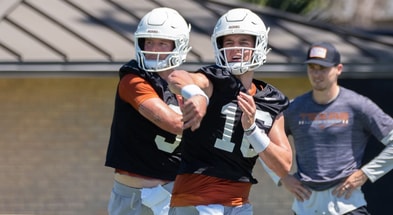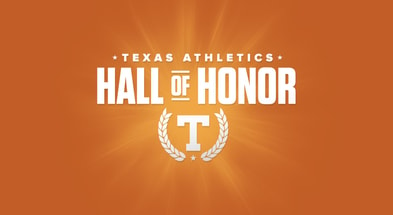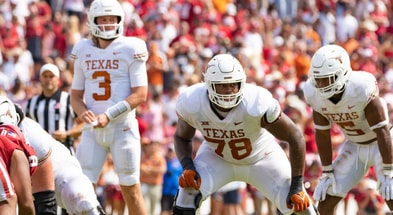Who Really Was The Big 12's Best Defense in 2022?
One of the merits of getting a full conference slate of results is that it allow apples to apples comparisons.
[Get FOUR MONTHS of Inside Texas Plus for $1!]
Well, not quite apples to apples, but at least it’s apple to quince instead of apples to lasagna. Or apples to dump trucks.
Limited conference universes are not true apples to apples because Iowa State’s defense never had the good fortune of playing Iowa State’s offense. The Kansas Jayhawks were also spared getting lit up by their own offense. Injuries can also have an impact. There’s little doubt that Texas was done a major statistical favor by not having to face Dillon Gabriel in Dallas, which would have turned a 49-0 utter demolition into a more conventional 52-28 woodshedding. Dillon Gabriel isn’t the best QB in the league, but OU had the steepest drop off from starter to back up in college football.
Nonetheless, round robins provide very useful data because it throws out questionable non-conference opponents and forces like against like. We also care more about what happens in our conference ecosystem in general. Baylor’s defense dominated non-con Albany and Texas State while the Longhorn defense faced potent non-con offenses like Alabama and UTSA. The idea that we can still glean data from these contests for comparison with the right statistical boundaries is unsophisticated. Yes, even if you “adjust” for strength. You can’t do it very well — even if the Football Outsiders tell you they can. Which they even acknowledge by throwing out FCS results vs FBS teams. There’s nothing to be gained in comparison by whether a team blew out a really bad team 48-7 or 69-7. But the human mind still wants to see the latter team as “more dominant.” I understand that. But no. Football doesn’t work that way.
Non-conference play, in combination with preseason hype, fuels false perceptions that still carry into November and December. And even into postseason All Big 12 selections (ahem).
So let’s make the data dance, add a little context, and see what we see. We’ll start big picture with scoring defense and then narrow our focus…
Scoring Defense
| Index | Team | G | TD | FG | XPT | 2XP | DXP | SAF | PTS | AVG/G |
|---|---|---|---|---|---|---|---|---|---|---|
| 1 | Texas | 9 | 25 | 9 | 23 | 1 | 0 | 1 | 204 | 22.7 |
| 2 | Kansas State | 10 | 28 | 13 | 21 | 2 | 0 | 0 | 232 | 23.2 |
| 3 | Iowa State | 9 | 27 | 9 | 27 | 0 | 0 | 0 | 216 | 24.0 |
| 4 | TCU | 10 | 33 | 10 | 33 | 0 | 0 | 0 | 261 | 26.1 |
| 5 | Baylor | 9 | 35 | 10 | 32 | 0 | 0 | 1 | 276 | 30.7 |
| 6 | Oklahoma State | 9 | 35 | 13 | 33 | 1 | 0 | 0 | 284 | 31.6 |
| 7 | Texas Tech | 9 | 34 | 16 | 33 | 1 | 0 | 0 | 287 | 31.9 |
| 8 | Oklahoma | 9 | 42 | 11 | 38 | 1 | 0 | 0 | 325 | 36.1 |
| 9 | Kansas | 9 | 43 | 12 | 39 | 2 | 0 | 1 | 339 | 37.7 |
| 10 | West Virginia | 9 | 43 | 13 | 39 | 1 | 1 | 0 | 340 | 37.8 |
Hey, points on the board is all that matters, right?
Sort of.
I’ve argued many times that scoring defense is a team measure, predominantly influenced by your defense. That subtle distinction is important. Scoring defense is a decent short hand, but it can be incredibly deceptive, such as when the defense being measured is saddled with a moribund turnover prone offense or poor special teams play. Complementary clock chewing offensive pace can also contribute to scoring defense illusions. Air Force plays pretty good defense, but nothing like the gross statistics imply. They have games where they might have to defend against only 6-7 offensive possessions. Playing very little defense is an illusory way of playing “good” defense.
If you’ll recall the Horns’ last game, Texas handled Baylor’s offense just fine but the Bears scored a safety and a defensive touchdown to fuel a 27 point total that suggested Baylor offensive efficacy to the casual box score scanner. That’s not really what happened though. The Texas defense clearly won their matchup. They can’t help it if the offense surrenders points and field position. For a more dramatic example, see TCU’s 62-14 decimation of Iowa State. A Frog track meet, right? Did Duggan throw for 450 yards? Not really. The Frogs had less than 400 yards of offense and averaged 5.5 yards per play. The Cyclone offense and special teams played poor “team defense.”
Points per game allowed generally does a solid job of identifying the middling to worst defenses as pure volume doesn’t lie, but it does a poor job of differentiating the elite. And a one game outlier (see TCU/ISU) can really skew the data.
Let’s talk about per play and gross volume efficacy instead…
Defensive Yardage
| Index | Team | G | RUSH | PASS | PLAYS | YDS | AVG/P | TD | AVG/G |
|---|---|---|---|---|---|---|---|---|---|
| 1 | Iowa State | 9 | 1108 | 1616 | 551 | 2724 | 4.9 | 25 | 302.7 |
| 2 | Texas | 9 | 1084 | 2219 | 676 | 3303 | 4.9 | 24 | 367.0 |
| 3 | TCU | 10 | 1641 | 2246 | 715 | 3887 | 5.4 | 32 | 388.7 |
| 4 | Kansas State | 10 | 1551 | 2377 | 692 | 3928 | 5.7 | 27 | 392.8 |
| 5 | Baylor | 9 | 1399 | 2174 | 621 | 3573 | 5.8 | 33 | 397.0 |
| 6 | Texas Tech | 9 | 1749 | 2344 | 664 | 4093 | 6.2 | 32 | 454.8 |
| 7 | West Virginia | 9 | 1607 | 2548 | 650 | 4155 | 6.4 | 41 | 461.7 |
| 8 | Oklahoma State | 9 | 1722 | 2438 | 698 | 4160 | 6.0 | 35 | 462.2 |
| 9 | Kansas | 9 | 1919 | 2402 | 701 | 4321 | 6.2 | 43 | 480.1 |
| 10 | Oklahoma | 9 | 1913 | 2555 | 740 | 4468 | 6.0 | 42 | 496.4 |
Now we’re drilling down closer to the truth. Notice that the top 4 performers from points per game remain near the top (albeit in different order) while the middle to dregs remain depressed. Gross yards per game allowed is a useful but deceptive metric. Look instead to yards allowed per play. Texas and Iowa State are the clear conference standouts at 4.9 yards per play with a clear separation from the rest of the league. TCU – the next closest team – is a half yard away. The rest of the league hovers around 6 yards per play. On this basis, the Kansas State defense comes down to earth vs. their points allowed per game metric (remember, offensive pace, special teams and their lack of offensive turnovers helps their “team defense”) while TCU looks better than is popularly perceived. This marries with what my eyes saw on the field.
Oklahoma State may be shocking to see at 6 yards per play allowed. On par with the leaky Sooners. The Cowboys had only one defensive competency that kept them in games…getting off of the field.
Opponent 3rd Down Conversions
| Index | Team | G | CONV | ATT | PCT |
|---|---|---|---|---|---|
| 1 | Oklahoma State | 9 | 39 | 138 | 28.3 |
| 2 | Iowa State | 9 | 36 | 118 | 30.5 |
| 3 | TCU | 10 | 48 | 147 | 32.7 |
| 4 | Kansas State | 10 | 51 | 140 | 36.4 |
| 5 | Texas | 9 | 57 | 146 | 39.0 |
| 6 | Texas Tech | 9 | 58 | 139 | 41.7 |
| 7 | Oklahoma | 9 | 63 | 148 | 42.6 |
| 8 | West Virginia | 9 | 56 | 126 | 44.4 |
| 9 | Kansas | 9 | 68 | 134 | 50.7 |
| 10 | Baylor | 9 | 61 | 116 | 52.6 |
Opponent 4th Down Conversions
| Index | Team | G | CONV | ATT | PCT |
|---|---|---|---|---|---|
| 1 | Texas Tech | 9 | 8 | 22 | 36.4 |
| 2 | Kansas State | 10 | 11 | 27 | 40.7 |
| 3 | Baylor | 9 | 5 | 12 | 41.7 |
| 4 | TCU | 10 | 15 | 31 | 48.4 |
| 5 | Oklahoma State | 9 | 13 | 25 | 52.0 |
| 6 | West Virginia | 9 | 13 | 21 | 61.9 |
| 7 | Texas | 9 | 17 | 27 | 63.0 |
| 8 | Oklahoma | 9 | 13 | 20 | 65.0 |
| 9 | Iowa State | 9 | 8 | 12 | 66.7 |
| 10 | Kansas | 9 | 16 | 22 | 72.7 |
Oklahoma State was fantastic at getting off of the field on 3rd down. In fact, I’ve never seen a larger spread between a defense’s ability to get off of the field in elite fashion to hemorrhaging big plays and yards on so many other downs. What an odd defense. Derek Mason was great at honing in on key downs while consistently getting whipped outside of them. It’s a bizarre asymmetry, but a useful one for the Cowboys. It’s a primary reason they upset a better Longhorn football team in Stillwater.
Iowa State was predictably great here and TCU also excelled. Credit TCU’s success to a very good and deeply experienced secondary (with a true lockdown cornerback) while Iowa State is a triumph of team defense in a system that they all know backwards and forwards. The Cyclones also have an underrated strength: every starting defender is at least average and most of them are above average to good. They all know their jobs really well. Otherwise good defenses pay an outsized cost for starting just one or two weak links.
Texas improved here over the course of the season, but this was the clear Achilles heel of the Longhorn defense and the subject of much of my early to mid season focus. Add in the miserable 4th down numbers for Texas and you have a statistical understanding of how the Horns faltered on the road against a feeble offense like Tech. They literally surrendered the only thing Tech could do. Texas got better on key downs as the season progressed, which is how the Longhorns obliterated very good offenses in Kansas and TCU later in the season.
If Texas had been better on money downs, the Horns would be unquestionably the league’s best defense. I’ll let you fill in the season record for yourself, but your guess should have double digit wins.
Poor Baylor couldn’t get off of the field on money downs. Part of the reason Aranda just fired his defensive coordinator.
What about advanced statistics, which factor in opponent strength, minimize garbage time and generally attempt to create a true apples to apples?
FEI National Ranking:
Iowa State – 7
Kansas State- 9
Texas- 10
TCU- 24
Texas Tech- 27
Oklahoma St- 30
Oklahoma – 43
Baylor – 48
West Virginia- 100
Kansas- 107
Advanced statistics are a major improvement over gross statistics, but I don’t think they are the final word as they don’t factor in key injuries. Similarly, the idea that pure metrics can differentiate the challenge level of Alabama vs. UMass can be fallacious, even if they have statistical controls that purport to tease that all out. You have to understand that there is game and season context not conveyed even by the most sophisticated statistics.
Interesting aside: while all fans rightfully love sacking the QB, Texas Tech led the league in sacks and still surrendered 6.2 yards per play. Iowa State was dead last in conference sacks. Texas finished 3rd, which may be surprising to some.
I hope this sheds a little light on the true performance level of Big 12 defenses. I think Iowa State was the league’s best unit, edging out Texas, which rallied late to becoming a truly good unit. Behind Texas, TCU and Kansas State. Who you prefer there is a matter of taste, but I probably favor the Frogs. Beyond them, you have a lot of flawed defenses with West Virginia and Kansas as the only truly poor units.
